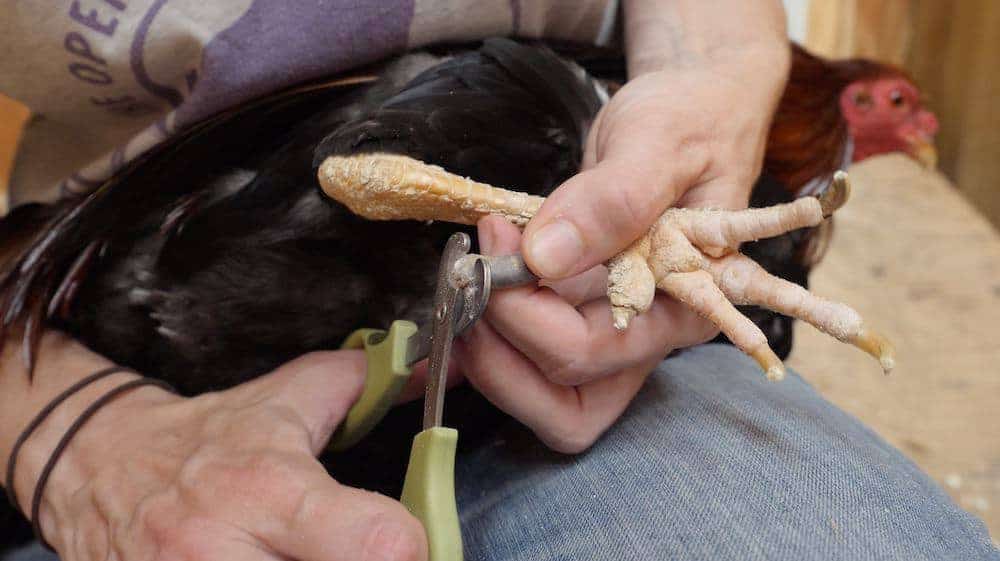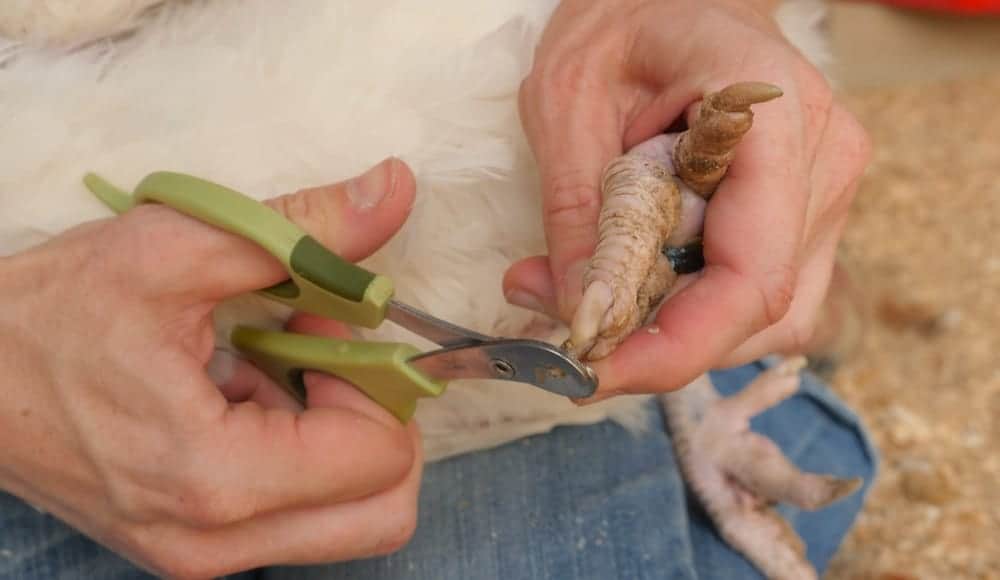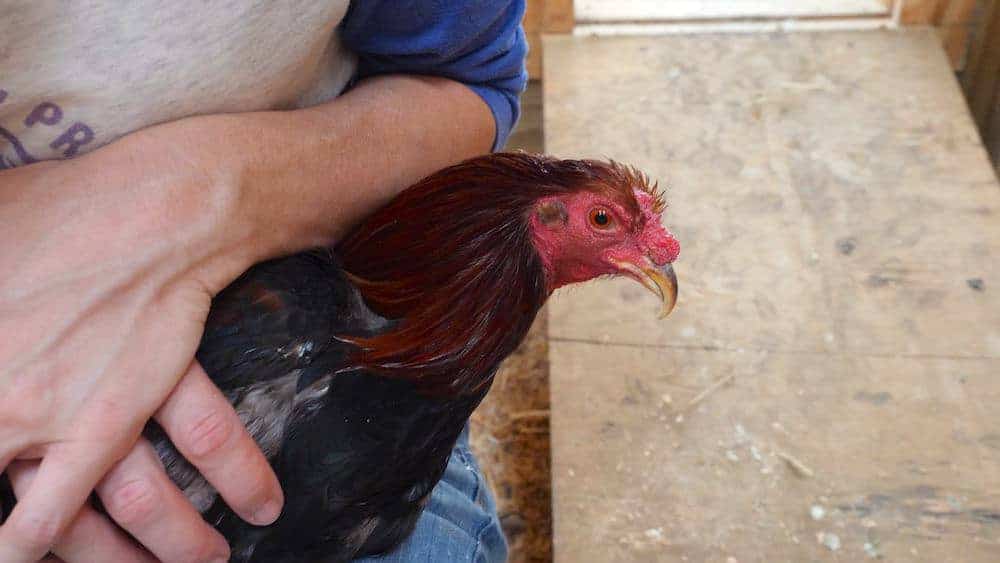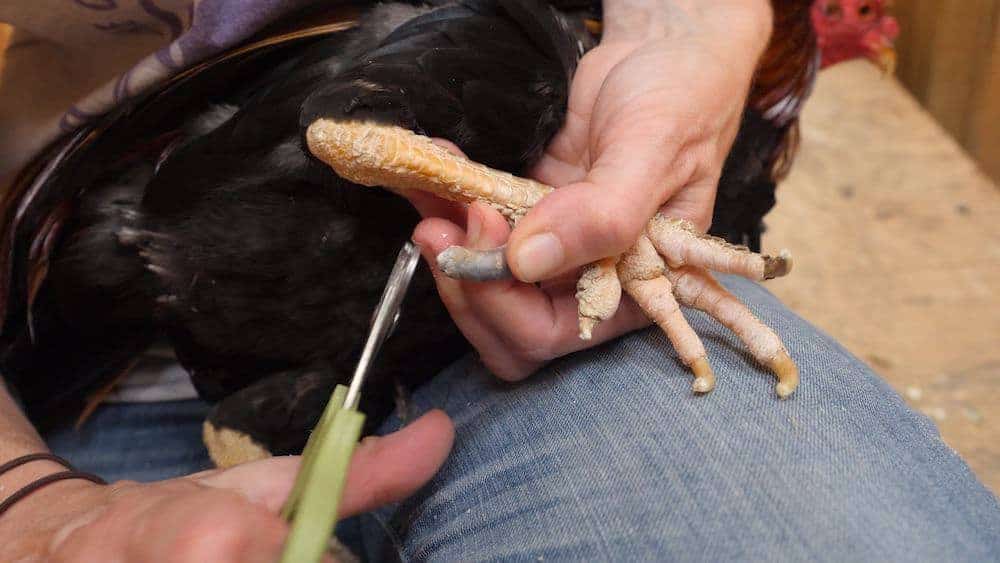
Updated July 30, 2021
Just like the nails on your hands and feet, chickens have nails and spurs sheathed in keratin on their feet and legs. The tip of their beak is also made out of keratin! And just like us, this consistently growing material needs to be maintained for their health. If, and how often these areas need trimmed varies a bit by individual, but generally speaking, roosters will need regular spur trimming to prevent their spurs from getting too long. Environmental factors as well as each individual’s activity level can contribute to whether or not they are able to wear their nails down naturally or if they need regular nail trimming. It’s good practice to evaluate each chicken’s nails during regular health examinations, and only trim them if needed. Many chickens who have full, normally aligned beaks will never need their beak trimmed, but individuals with crossed beaks or who have been debeaked may need regular beak trimmings. That’s not to say that chickens without those issues will never need their beaks trimmed, but it is less common. Rather than thinking of routine health examinations as the time for nail, spur, or beak trimming, instead think of it as scheduled time to evaluate whether or not trimming is needed or may be needed soon (in addition to making this evaluation part of your daily observation).
Trimming a beak is very different than debeaking (which the commercial poultry industry refers to as “chicken beak trimming” quite disingenuously), a violent and disfiguring practice that causes permanent physical and psychological damage to chickens. Safe beak trimming is no more harmful than trimming your fingernails!
Signs You Should Step In
You should schedule a trimming if a chicken’s toenails begin to grow long, become dangerously sharp, begin to curl, or become ingrown (sometimes in circumstances where they don’t have enough hard surfaces to scratch against, sometimes by virtue of their genetics). Certain chicken breeds, including Dorkings, Faverolles, Houdans, Sultans, and Silkies all have five toes, with an extra toe that grows above their hind toe with an upward curve. This toenail will never touch the ground and absolutely needs to be trimmed for their health.
With beaks, it’s important to ensure that they’re properly growing and wearing down. If their upper beak begins to grow much longer than their lower beak, you should trim or file it down. If the upper beak is allowed to grow too much, it can interfere with eating, pecking, and preening.
You may notice that a chicken’s beak grows in the wrong direction (a common, sometimes lifelong condition known as Scissor Beak). As this condition can interfere with regular pecking and prevent the beak from being worn down, it’s important to frequently trim an afflicted chicken’s beak for their health and wellbeing.
A chicken’s spurs (roosters have them and some hens might as well) are leg bone outgrowths that can be sharply covered in keratin as the chicken matures (this is known as a spur sheath). If their spur gets too long, it can affect their ability to walk, especially if it curls back into their leg or knocks against the opposite spur. The spur can also become dangerously sharp and may need to be trimmed to protect other birds or yourself.
If at all possible, have a veterinarian or expert give you hands-on training for these procedures! There are nuances in trimming technique that can not be conveyed through words alone.
It’s doubly important to make sure that roosters have trimmed nails and spurs as they have a tendency to mount other birds and their spurs can lacerate a hen down to the bone. These wounds are hard to see without picking up the hen and looking through her feathers. Pay close attention to anyone who appears to have feather damage from frequent mounting and check them often. Even trimmed spurs can cause deep mounting wounds, so it’s a good idea to also keep them covered with dog nail covers.
Pre-Trimming Suggestions
Carefully corral and pick up the chicken. If they’re too stressed to be held, you must set them down and give them time to calm down before trying again. This process may be aided with a second set of helping hands holding the chicken if you or the birds are nervous!
Consider setting out all of your supplies in an easily-accessible area so you can get the work done quickly.
How To Trim A Chicken’s Nails

Trimming a chicken’s nails is very similar to trimming a cat’s or dog’s nails. Like cats and dogs, chickens also have a sensitive area made of soft tissue in the center of their claws known as the quick. Cutting the quick by accident can be painful and bloody, so it’s important to be very mindful about how much you trim.
You can make the process of nail trimming easier by soaking their feet in warm water or cleaning them thoroughly with a damp rag prior to trimming. Soaking softens the nails which makes them much easier to clip without the nail splitting. Clean toes also make the quick much easier to identify! Other ways to find the quick include looking underneath the nail rather than at the top or sides, or using a flashlight right against the nail to illuminate the interior.
Gently rotate the bird onto their side. Cradle the chicken into your arm to keep their wings secure. They should calm down a bit after some secure, gentle holding. If by yourself, use one hand to hold their foot and the other to do the trimming. Secure their toe with your thumb and forefinger to hold it still. They might be touchy- this isn’t out of pain but because of distaste towards their feet being touched.
Using a cleaned pair of pet or human toenail clippers, trim a little bit of the chicken’s nails at a time, not trimming past about ⅛ inches as you go to prevent accidental quick cutting. Each time you snip, take a look at the remaining nail. If it changes color, you’re very close to the quick and should stop trimming. If the nail is still too long and you’re near the quick (as it grows and recedes depending on overall nail length), you can wait a few weeks for the quick to retreat and then trim a little more, repeating the process of trimming and waiting until their nails reach a safe length.
In some instances, after you’ve trimmed the nails you may need to file down the remaining rough edges with an emery board or nail file to protect the chicken from injuring themself when they scratch. Make sure to clean nail clippers if they become dirty or come into contact with blood from hitting the quick before using them to trim another animal’s nails.
If you do accidentally draw blood, apply an astringent like a styptic pencil, styptic powder (such as Quick Stop), alum, or witch hazel. You can also dip the wound in cornstarch or flour to encourage natural clotting. Lacking these tools, you can also use a piece of toilet paper as if you’d nicked yourself shaving! If the bleeding doesn’t stop, you can use the tip of your finger to apply pressure for up to a minute and repeating until any bleeding ends. If you’re going to return a chicken with a nicked quick to the flock, be sure to wait until the blood is definitely stopped and cleaned as chickens tend to peck at flockmates’ open wounds.
Video Resource: Safely Trimming A Chicken’s Nails
How To Trim A Chicken’s Beak

Although beak trimming as needed is safe, be very careful not to hit the quick. Cutting into the quick in their toenail is painful, but cutting into the quick in their beak is even more serious and can make it difficult for the bird to eat comfortably. It’s best to be conservative when trimming the beak and to ensure you can see the quick so you know how much you can trim. If you do hit the quick accidentally, pay close attention to how the bird behaves. They may need pain management for a few days and might benefit from soft foods rather than hard pellets.
If you need to trim or file a chicken’s beak, how overlong it’s grown will determine what technique to use. A small amount of overhang of the top beak is normal in most individuals. If the upper beak is just beginning to get too long, you can use a fingernail file or emery board to file it down a little bit. If it’s gotten past that point, you can use cleaned petAn animal who spends regular time with humans in their home and life for companionship or human pleasure. Typically a small subset of animal species are considered to be pets by the general public. or human nail clippers to very gradually trim down the excess in a similar fashion to their nails. The beak also contains a quick that you need to carefully avoid snipping at risk of blood and pain. The part that needs to be trimmed is often colored a little lighter and is more translucent than the rest of the beak. If you’re concerned, you can look into the chicken’s mouth to quickly discern where the beak’s quick ends. Make sure to hold their head securely when trimming. Beak trimming is much easier with a helper holding the bird!
It’s rare for the lower beak to require trimming, unless they have a condition like Scissor Beak or have been severely debeaked.
Follow the same procedure and considerations as the nail trimming guide in case you draw blood.
Video Resource: Safely Trimming A Chicken’s Beak
How To Trim A Chicken’s Spurs

If you need to trim a chicken’s spurs, you can blunt it with cleaned wire cutters, pet or human nail clippers, or even a Dremel with the proper sanding attachment. Like their nails, the spura stiff sharp spine (as on the wings or legs of a bird or insect) contains live tissue known as the quick (or calcar in the case of spurs). The quick continues to grow as the spur grows, so be sure to just trim a little bit at a time. If you see you are approaching the quick but the spur is still long, you may need to trim a little bit every week or so until they are at a reasonable length. Hold the chicken’s foot securely while trimming the spur to minimize risk of injury. It’s also a good idea to stabilize the base of the spur and ensure you are not putting undo pressure on the spur which could cause damage or even cause the spur to break, which is both painful and bloody. Once trimmed, you can blunt the edge with a nail file or emery board.
It’s possible that the spur sheath might fall off entirely, leaving sensitive quick. In this case, make sure to address any bleeding and keep the chicken clean until a new spur sheath starts to develop or the remaining tissue dries out and hardens. They may be particularly touchy and prone to pain in this period. A few days of pain medication and keeping the area protected with a padded, non-adherent wrap can help keep the bird more comfortable. If the entire spur falls off due to severe trauma, it will not regrow.
If you want to keep trimmed spurs safe for other residents living with a rooster, you can apply extra large-size dog claw silicone tips using with the supplied adhesive directly onto the spur, as long as it is not bleeding (different brands of nail covers offer different sizes- for most non-bantam breeds you will need the largest size offered, sometimes called “jumbo” or “XXXL”). When you need to trim the spur again, simply trim off the tip of the silicone cover and then remove the remaining portion before trimming as you normally would. Then apply a new spur cover on the newly blunted tip.
Follow the same procedure and considerations as the nail trimming guide in case you draw blood.
Video Resource: Safely Trimming A Chicken’s Spurs
Once you’ve managed a few chicken’s nails, you’ll be a proud poultry pedicure provider in no time!
SOURCES:
Care Of Beak, Nails, And Spurs in Backyard/Fancy Poultry | Francine A. Bradley, Ph.D. Extension Poultry Specialist, UC Davis (Non-Compassionate Source)
Trimming Your Chicken’s Nails | Backyard Chickens (Non-Compassionate Source)
How To Trim Chicken’s Toenails | Tilly’s Nest (Non-Compassionate Source)
Trimming Chicken Beaks, Claws, & Spurs | Countryside Network (Non-Compassionate Source)
If a source includes the (Non-Compassionate Source) tag, it means that we do not endorse that particular source’s views about animals, even if some of their insights are valuable from a care perspective. See a more detailed explanation here.








